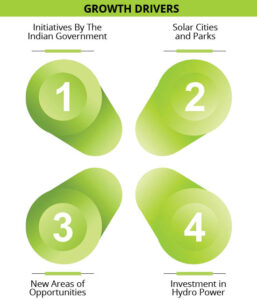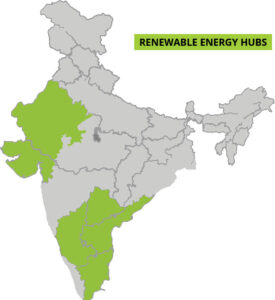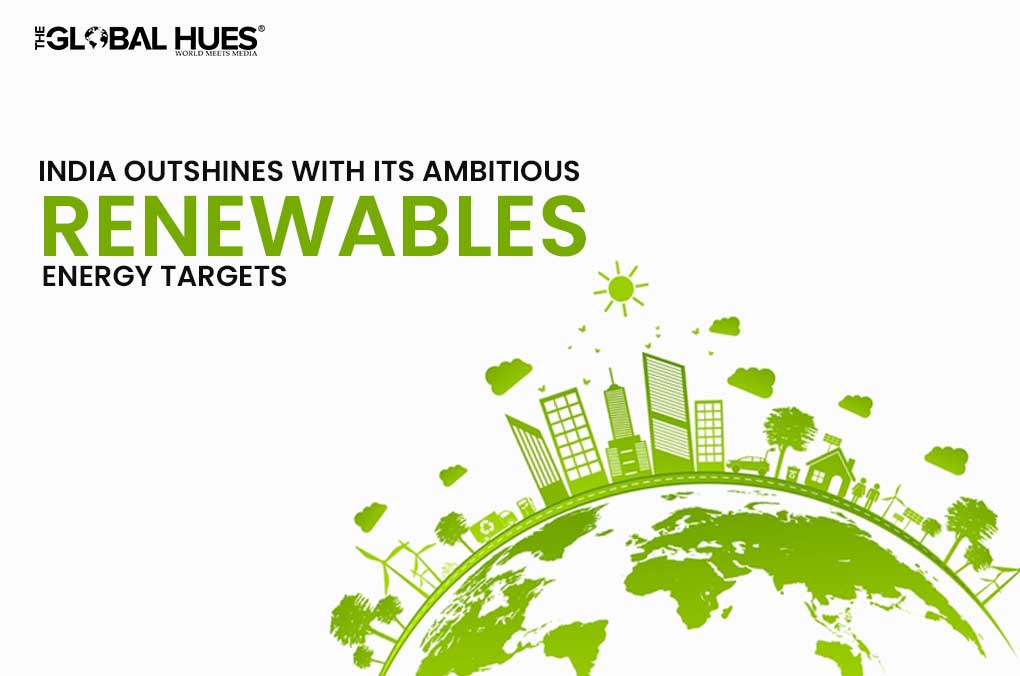Highlights:
- Investment by India in renewable energy hit a record at US $14.5 Billion in 2021 22, witnessing an increase of a whopping 125% over the FY 2020 21.
- India has set an ambitious target to achieve a capacity of 175 GW worth of renewable energy by the end of 2022, which expands to 523 GW (including 73 GW from Hydro) by 2030.
- India has ranked third on the EY Renewable Energy Country Attractive Index 2021.
- India is the 4th largest installed capacity of wind power and the fifth largest solar installed capacity in the world.
- In the budget, the government allocated Rs. 19,500 crores (US$ 2.57 billion) for a Production Linked Incentive (PLI) scheme to boost the manufacturing of high-efficiency solar modules.
There is no alternative to protecting the climate without dramatically transforming how the world uses energy. We can surely turn things around. The solution is Renewable Energy.
“A nation that leads in renewable energy will be the nation that leads the world.” Such a powerful line by James Cameron reflects how important it is for us to switch to renewable and clean energy.
According to a report by Institute for Energy Economics and Financial Analysis, India has made remarkable progress in the renewable energy space in the Fiscal Year (FY) 2021-22. The country has installed a record 15.5 gigawatts (GW) of renewable capacity – 50% more than the 10GW added in FY2020-2021.
Investment by India in renewable energy hit a record at the US $14.5 Billion in 2021-22, witnessing an increase of a whopping 125% over the FY 2020-21.
By the year 2040, it is expected that around 49% of the total electricity will be generated by renewable energy as more efficient batteries will be used to store electricity, which will further result in cutting the solar energy cost by 66% as compared to the current cost.
The Government of India is working towards building a clean, resilient, and least-cost energy future for India and thus, laying the foundations of effective initiatives and policies to drive investment and developments in some new clean energy technologies.
GROWTH DRIVERS

India has set an ambitious target to achieve a capacity of 175 GW worth of renewable energy by the end of 2022, which expands to 523 GW (including 73 GW from Hydro) by 2030. It has ranked third on the EY Renewable Energy Country Attractive Index 2021.
Here are the growth drivers of the industry:
-
Initiatives By The Indian Government
In the Union Budget 2022-23, the allocation for the Solar Energy Corporation of India (SECI), a company of the Ministry of New and Renewable Energy, incepted to facilitate the implementation of the National Solar Mission, stood at Rs. 1,000 crores (US$ 132 million).
In the budget, the government allocated Rs. 19,500 crores (US$ 2.57 billion) for a Production Linked Incentive (PLI) scheme to boost the manufacturing of high-efficiency solar modules. Companies approved for the PLI scheme are Maruti Suzuki, Toyota, Bosch, Hero MotoCorp, Motherson Sumi, and Hero Cycles.
The carbon footprint of The Indian Railways is massive as it transports millions of passengers every day across the subcontinent. It is taking a multi-pronged approach to go green and become a ‘net-zero’ carbon emitter by 2030.
Union Environment Minister Bhupender Yadav on November 25, 2021, while asserting the need to take a serious note on sustainability said, “As a nation, we would reach net-zero emissions removing as much as carbon dioxide from the atmosphere as we produce by 2070.”
-
Solar Cities and Parks
In September 2021, according to a statement from the Ministry of New and Renewable Energy (MNRE), India approved 45 solar parks with a cumulative capacity of 37 gigawatts (GW) under the solar park scheme.
If we talk about Solar Cities, a total of 24 states and union territories have identified cities to be developed as solar cities.
These are Assam, Bihar, Chhattisgarh, Delhi, Gujarat, Haryana, Uttarakhand, West Bengal, Karnataka, Kerala, Punjab, Goa, Madhya Pradesh, Meghalaya, Odisha, Tripura, Mizoram, Rajasthan, Uttar Pradesh, Himachal Pradesh, Jharkhand, Andaman and Nicobar, Sikkim, Daman and Diu, and Dadra and Nagar Haveli.
-
New Areas of Opportunities
-
Green Hydrogen:
According to the nomenclature used by Wood Mackenzie, a market research firm, most of the gas used as an industrial chemical is either brown or grey. Neither of these processes is carbon friendly. To the rescue, we have a purportedly cleaner option – Hydrogen.
The Central government has planned to launch a Green Hydrogen Mission which is expected to announce a green hydrogen purchase obligation in fertilizer production and petroleum refining, akin to renewable purchase obligations (RPO). The Mission has an expected outcome of generating 4.1 Mn Tonnes of annual Green Hydrogen production.
-
Floating PV Projects:
India has been making tremendous progress in floating solar power. The top five upcoming floating solar power projects in India are:
- Omkareshwar Reservoir (600MW)
- Ramagundam Reservoir (100 MW)
- Kayamkulam Project (92 MW)
- Getalsud dam project (100MW)
- Rihand Dam (50MW)
-
Investment in Hydro Power
As the country is setting ambitious goals to increase the usage of renewable energies, hydropower can help meet the goals.
In 2020, India surpassed Japan to become the nation with the fifth-largest hydropower production capacity in the world. According to International Energy Agency (IEA), India will add 26,000 megawatts (MW) of hydropower projects by 2030.
Currently, there are about 207 hydropower projects in India with an installed capacity of 46,209 MW. At present, more than 9,000 MW of large hydro projects are in the construction stage in the country.
RENEWABLE ENERGY HUBS

- Rajasthan
- Gujarat
- Andhra Pradesh
- Karnataka
- Telangana
- Tamil Nadu
According to the data released by the Ministry of New and Renewable Energy, Rajasthan has become the leading state in India to produce the highest amount of renewable energy. It has jumped three spots in the overall production of renewable energy with a whopping 17040.62 MW, including wind energy, solar energy and bioenergy.
THE PATH FORWARD
The Government of India is committed to increasing the use of clean energy sources and it is quite clear after looking at various policies, schemes, and initiatives taken by them. Meanwhile, the renewable energy sector has the potential to provide employment to the unemployed people of the country. As the nation increases its focus on electric vehicles, manufacturing of solar equipment, and green hydrogen, India’s renewable energy sector is expected to boom in 2022.
Source: The information in this report has been obtained from the India Brand Equity Foundation, a Trust established by the Department of Commerce, Ministry of Commerce and Industry, Government of India and the National Investment Promotion & Facilitation Agency of India, a non-profit venture under the aegis of Department for Promotion of Industry and Internal Trade, Ministry of Commerce and Industry, Government of India.
Must Read:
- TOP 10 RICHEST BILLIONAIRES IN THE WORLD 2022
- Top 10 Indian Origin CEOs Leading International Companies
- TOP 10 IN-DEMAND SKILLS FOR 2022
- SUCCESS STORY OF TIM COOK: A MAN WITH A VISION
- HIGHEST-PAID CEOs IN THE WORLD
- Success Story Of Mukesh Ambani
- TOP 10 NEWSPAPERS IN THE WORLD 2022
- Elon Musk: Biography Of A Self-Made Entrepreneur And Billionaire
- 10 GADGETS TO KEEP YOU COOL THIS SUMMER
- 7 R’s Of Waste Management – Steps To Sustainability
- What Are The 5 Must Watch Netflix Thrillers



